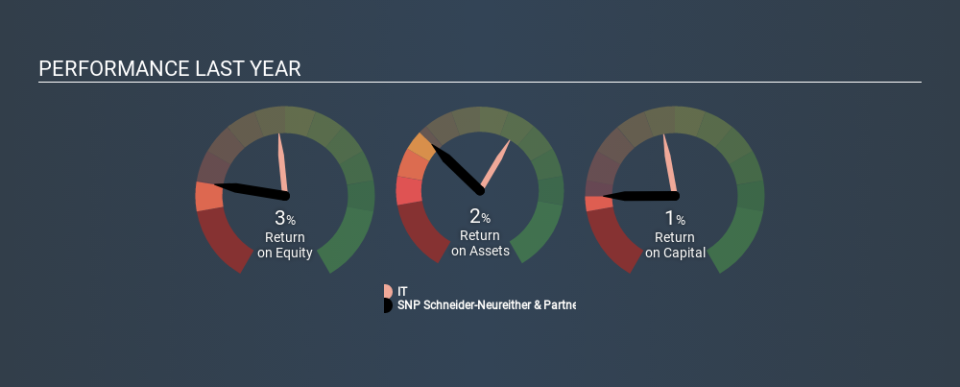Here’s why SNP Schneider-Neureither & Partner SE’s (ETR:SHF) Returns On Capital Matters So Much

Today we'll look at SNP Schneider-Neureither & Partner SE (ETR:SHF) and reflect on its potential as an investment. In particular, we'll consider its Return On Capital Employed (ROCE), as that can give us insight into how profitably the company is able to employ capital in its business.
First of all, we'll work out how to calculate ROCE. Then we'll compare its ROCE to similar companies. Finally, we'll look at how its current liabilities affect its ROCE.
Return On Capital Employed (ROCE): What is it?
ROCE measures the amount of pre-tax profits a company can generate from the capital employed in its business. Generally speaking a higher ROCE is better. Overall, it is a valuable metric that has its flaws. Renowned investment researcher Michael Mauboussin has suggested that a high ROCE can indicate that 'one dollar invested in the company generates value of more than one dollar'.
How Do You Calculate Return On Capital Employed?
The formula for calculating the return on capital employed is:
Return on Capital Employed = Earnings Before Interest and Tax (EBIT) ÷ (Total Assets - Current Liabilities)
Or for SNP Schneider-Neureither & Partner:
0.012 = €1.4m ÷ (€158m - €40m) (Based on the trailing twelve months to September 2019.)
Therefore, SNP Schneider-Neureither & Partner has an ROCE of 1.2%.
Check out our latest analysis for SNP Schneider-Neureither & Partner
Is SNP Schneider-Neureither & Partner's ROCE Good?
One way to assess ROCE is to compare similar companies. We can see SNP Schneider-Neureither & Partner's ROCE is meaningfully below the IT industry average of 10%. This performance is not ideal, as it suggests the company may not be deploying its capital as effectively as some competitors. Independently of how SNP Schneider-Neureither & Partner compares to its industry, its ROCE in absolute terms is low; especially compared to the ~-0.4% available in government bonds. It is likely that there are more attractive prospects out there.
SNP Schneider-Neureither & Partner's current ROCE of 1.2% is lower than 3 years ago, when the company reported a 11% ROCE. Therefore we wonder if the company is facing new headwinds. You can click on the image below to see (in greater detail) how SNP Schneider-Neureither & Partner's past growth compares to other companies.
Remember that this metric is backwards looking - it shows what has happened in the past, and does not accurately predict the future. ROCE can be misleading for companies in cyclical industries, with returns looking impressive during the boom times, but very weak during the busts. ROCE is only a point-in-time measure. What happens in the future is pretty important for investors, so we have prepared a free report on analyst forecasts for SNP Schneider-Neureither & Partner.
Do SNP Schneider-Neureither & Partner's Current Liabilities Skew Its ROCE?
Liabilities, such as supplier bills and bank overdrafts, are referred to as current liabilities if they need to be paid within 12 months. The ROCE equation subtracts current liabilities from capital employed, so a company with a lot of current liabilities appears to have less capital employed, and a higher ROCE than otherwise. To check the impact of this, we calculate if a company has high current liabilities relative to its total assets.
SNP Schneider-Neureither & Partner has total liabilities of €40m and total assets of €158m. Therefore its current liabilities are equivalent to approximately 26% of its total assets. With a very reasonable level of current liabilities, so the impact on ROCE is fairly minimal.
Our Take On SNP Schneider-Neureither & Partner's ROCE
That's not a bad thing, however SNP Schneider-Neureither & Partner has a weak ROCE and may not be an attractive investment. Of course, you might find a fantastic investment by looking at a few good candidates. So take a peek at this free list of companies with modest (or no) debt, trading on a P/E below 20.
If you are like me, then you will not want to miss this free list of growing companies that insiders are buying.
If you spot an error that warrants correction, please contact the editor at editorial-team@simplywallst.com. This article by Simply Wall St is general in nature. It does not constitute a recommendation to buy or sell any stock, and does not take account of your objectives, or your financial situation. Simply Wall St has no position in the stocks mentioned.
We aim to bring you long-term focused research analysis driven by fundamental data. Note that our analysis may not factor in the latest price-sensitive company announcements or qualitative material. Thank you for reading.


